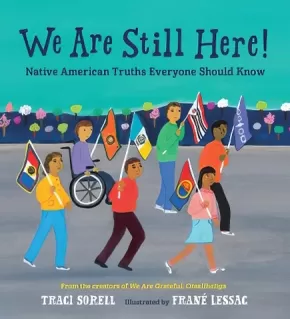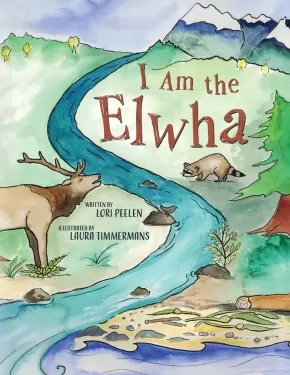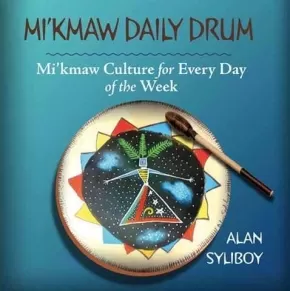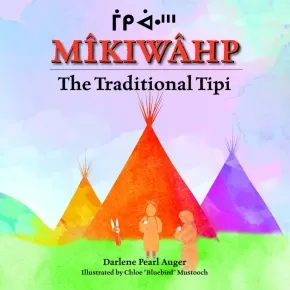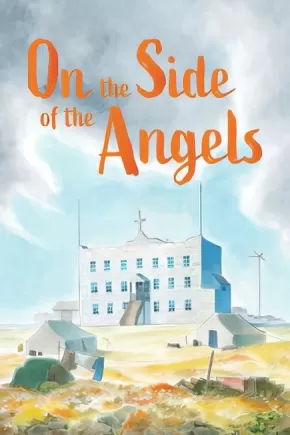
Social Studies
166
-
180
of
405 Results;
Sort By
Go To
of 27
This Is What I've Been Told
$16.99
Artists:
Format:
Paperback
Text Content Territories:
Indigenous Canadian; First Nations; Anishinaabeg; Ojibway;
ISBN / Barcode: 9781989122693
Synopsis:
Synopsis:
Knowing our culture means knowing who we are. When we know who we are, we can walk in a good way.
It's been said when teachings are passed down from one generation to the next, good things can happen. Language is learned, knowledge is shared and culture is practiced. In this story of language preservation, author/illustrator and Anishnaabemowin language teacher Juliana Armstrong illuminates a number of Anishnaabemowin words along with their cultural connections, passed down from her Ojibway ancestors. Knowing our culture means knowing who we are. When we know who we are, we can walk in a good way.
Educator Information
Recommended for ages 6 to 8
This book shares Anishnaabemowin words, their cultural connections and how to say them, with the help of phonetics.
A story of Indigenous language preservation and revitalization.
This authentic book is written and illustrated by an Ojibway artist and Anishnaabemowin language teacher.
A teacher lesson plan is available: This Is What I've Been Told Teacher Lesson Plan
This book is available in French: C'est ce qu'on m'a dit
Additional Information
40 pages | 11.00" x 8.50"
Treaty Words: For As Long As the Rivers Flow
$16.95
Format:
Hardcover
Text Content Territories:
Indigenous Canadian; First Nations; Anishinaabeg;
ISBN / Barcode: 9781773214962
Synopsis:
Synopsis:
The first treaty that was made was between the earth and the sky. It was an agreement to work together. We build all of our treaties on that original treaty.
On the banks of the river that have been Mishomis’s home his whole life, he teaches his granddaughter to listen—to hear both the sounds and the silences, and so to learn her place in Creation. Most importantly, he teaches her about treaties—the bonds of reciprocity and renewal that endure for as long as the sun shines, the grass grows, and the rivers flow.
Accompanied by beautiful illustrations by Luke Swinson and an author’s note at the end, Aimée Craft affirms the importance of understanding an Indigenous perspective on treaties in this evocative book that is essential for readers of all ages.
Awards
- 2022 Indigenous Voices Award in the graphic novels, comics, and illustrated books category
Educator Information
Recommended for ages 10+
Target Grade: Grade 5
Reading Level: Lexile 920L
CCSS.ELA-Literacy Strand-Reading literature:
SL.3.1,1a,1b,1c,1d,2
W.3.1,1a.1b,1c,1d,1e
L.3.1,1a,1b,1c,1d.1e
RL.3.1,2,3,4,5,6,7,9
This book is available in French: Mishomis raconte les traités: Tant que les rivières couleront
Additional Information
60 pages | 4.00" x 6.00"
We Are Still Here!: Native American Truths Everyone Should Know
$21.99
Artists:
Format:
Hardcover
Text Content Territories:
Indigenous American; Native American;
ISBN / Barcode: 9781623541927
Synopsis:
Synopsis:
Twelve Native American kids present historical and contemporary laws, policies, struggles, and victories in Native life, each with a powerful refrain: We are still here!
Too often, Native American history is treated as a finished chapter instead of relevant and ongoing. This companion book to the award-winning We Are Grateful: Otsaliheliga offers readers everything they never learned in school about Native American people's past, present, and future. Precise, lyrical writing presents topics including: forced assimilation (such as boarding schools), land allotment and Native tribal reorganization, termination (the US government not recognizing tribes as nations), Native urban relocation (from reservations), self-determination (tribal self-empowerment), Native civil rights, the Indian Child Welfare Act (ICWA), religious freedom, economic development (including casino development), Native language revival efforts, cultural persistence, and nationhood.
Reviews
"Students at the Native Nations Community School share presentations about the history, present, and future of Indigenous communities. The vivid artwork features a simple, bold style. The narrative starts with a general introduction of Native Nations in the United States. Each presentation contains illustrations with the student’s name, an overview of the subject, a brief list of the impact that the concept or historical moment had on Native American people, and the refrain “We Are Still Here!” The last pages show students and their families with a variety of skin tones and physical abilities studying the presentations on topics that include sovereign rights and relocation. Additional information, a timeline, a glossary, sources, and an author’s note offer further context. The lyrical text and jewel-tone illustrations elegantly work together to stirringly portray the ongoing fight for Native American recognition and rights. VERDICT An essential purchase for introducing the impact laws and treaties had and continue to have on Native Nations." —School Library Journal, starred review
"In this meticulously researched nonfiction picture book, Sibert honorees Sorell and Lessac team up once again to answer this question: What has happened to Native Nations and their citizens after the treaties with the U.S. government ended in 1871? Lessac’s trademark colorful, folk-art–style illustrations show a Native American community school with a classroom of diverse students preparing for presentations at the Indigenous People’s Day assembly. Spread by spread, each child speaks, featured words and terms highlighting the journey Native Nations have taken to reclaim their land and rights. They show why Indigenous people say, “We are still here!” In the “Assimilation” presentation, Native children are dressed in militarylike uniforms, showing how U.S. leaders used schooling to destroy Native traditions. Dividing plots of tribal land for “Allottment” left much treaty land open for public sale. With “Termination” and “Relocation,” Native people were encouraged to leave their tribal lands and “act more like white people.” But Indigenous people say, “We are still here!” and the narrative arc turns to emphasize resilience. When activists speak up and organize, it strengthens tribal sovereignty. The tribes “protect and provide for future generations” by holding on to their traditional ceremonies, opening businesses to support their tribal members, and reviving their tribal languages. The illustrations, too, change their tenor, modulating from historical wrongs to emphasize contemporary strength, community, and joy. An emphatic, triumphant declaration: “WE ARE STILL HERE!”" —Kirkus Reviews, starred review
Educator Information
Recommended for ages 7 to 10.
This book has a Native American focus.
Additional Information
40 pages | 9.88" x 10.81"
White Privilege: Deal With It In All Fairness
$24.95
Artists:
Format:
Hardcover
ISBN / Barcode: 9781459416215
Synopsis:
Synopsis:
For some kids, ways they can help eliminate racial injustice might be hard to see. After all, they are taught that people in society are all equal under the law. So why then does racial conflict still exist? And what can they as individuals do about it right now? One way is for white children to understand the unearned advantages they were born with based solely on the colour of their skin. This concept is called white privilege and this book will help children of all races understand it, see how it affects them and find ways to speak out and take real action against it.
White Privilege: Deal with it in all fairness provides scenarios, quizzes and Q&As that develop readers’ understanding of the subject using situations that are realistic and that easily relate to their everyday lives. The topic is approached from three points of view: those who are “privileged,” those who identify as “racialized” and those who want to be allies.
Educator & Series Information
Recommended for ages 9 to 14.
The Deal With It series helps adolescents cope with conflicts in everyday life and promote peaceful homes, schools, and communities.
Additional Information
32 pages | 8.50" x 11.02" | Library Binding
Housing and Infrastructure (2 in Stock)
$31.95
Text Content Territories:
Indigenous Canadian;
ISBN / Barcode: 9781773087979
Synopsis:
Synopsis:
Colour Photographs, Black & White photographs, and Illustrations, Table of Contents, Maps, Glossary, For Further Information, Side Bars, Framing Questions, Index and Web Sites are all included.
Educator Information
Juvenile Nonfiction.
Additional Information
32 Pages | Library Binding
I Am the Elwha (HC)
 $18.50
$18.50

Artists:
Format:
Hardcover
Text Content Territories:
Indigenous American; Native American; Salish; Coast Salish; Klallam (Clallam); Lower Elwha Klallam Tribe;
ISBN / Barcode: 9781771744744
Synopsis:
Synopsis:
“I am the Elwha, rushing down to the sea. I am the Elwha, wild and free.”
The Elwha River flows 72 kilometres (45 miles) from its source in the Olympic Mountains to the Strait of Juan de Fuca in the Pacific Northwest. Uniquely, it hosts all six salmon species (Pink, Chinook, Coho, Sockeye, Steelhead, and Chum) as well as several species of trout.
In 1911 two dams were built on the river. The dams blocked the migration routes of the salmon and dramatically altered the entire river ecosystem for 100 years. In 2012 the dams were decommissioned and the world’s largest dam removal and habitat restoration project began.
In this lyrical and beautifully illustrated book, the author chronicles the history of the Elwha. Narrated by the powerful voices of plants and animals that inhabit the river ecosystem, the dam builder, a worker, and the river itself, this story celebrates the ongoing rewilding of this special environment and offers a welcome to all of the creatures who are coming home.
To learn more visit: www.elwha.org
Awards
- 2021 Riverby Award for Young Readers
Reviews
“I Am the Elwha is a powerful read about a powerful river and those who value and protect it." – Raina Delisle, Hakai Magazine
Educator Information
At the back of the book are three pages of cultural, scientific, and historical information that discuss the following:
- the importance and symbolism of salmon to the Lower Elwha Klallam Tribe and other Coastal Salish Tribes
- facts about the six species of salmon found in the Elwha River (Chinook, Pink, Chum, Sockeye, Coho, and Steelhead)
- the history of the Elwha River and its status today
Keywords / Subjects: The Elwha River, Rivers, Dams, History, Environmental Awareness, Lower Elwha Klallam Tribe, Coast Salish, Native American, Culture, Washington, Animals, Salmon, First Salmon Ceremony, Plants, Nature, Settlers, Social Responsibility, Environmental Activism, Poetry.
Recommended for grades 3 to 7.
Additional Information
32 Pages | 8.5" x 11" | ISBN: 9781771744744 | Hardcover
Authenticity Note: This lyrical story, which chronicles the history of the Elwha River, is written by Lori Peelen. Robert Elofson, Tribal Elder and Harvest Manager in the Natural Resources Department for the Lower Elwha Klallam Tribes, approved Lori's work and contributed a few pages of back matter at the end of the work. Lori's story was further approved by Frances Charles, the Tribal Councilwoman for the Lower Elwha Klallam Tribe, after the entire council read and approved it.
The Canadian Content label has been applied because the illustrator of this work is Canadian.
If You Want to Visit a Sea Garden
$18.99
Format:
Hardcover
Text Content Territories:
Indigenous Canadian;
ISBN / Barcode: 9781554989706
Synopsis:
Synopsis:
Discover the wonder of ancient sea gardens on the Northwest Coast
Sea gardens have been created by First Peoples on the Northwest coast for more than three thousand years. These gardens consist of stone reefs that are constructed at the lowest tide line, encouraging the growth of clams and other marine life on the gently sloped beach.
This lyrical story follows a young child and an older family member who set out to visit a sea garden early one morning, as the lowest tides often occur at dawn. After anchoring their boat, they explore the beach, discover the many sea creatures that live there, hear the sputtering of clams and look closely at the reef. They reflect on the people who built the wall long ago, as well as those who have maintained it over the years. After digging for clams, they tidy up the beach, then return home.
An author’s note provides further information about sea gardens (also known as clam gardens), which yield a reliable food source and have been traditional places of learning. They have been found along the Pacific coast, from Alaska to British Columbia to Washington State, and some of these gardens are being restored today.
The manuscript has been vetted and approved by the scientists of the Clam Garden Network and Kwaxsistalla Wathl’thla Clan Chief Adam Dick. Roy Henry Vickers, whose ancestry includes the Tsimshian, Haida and Heiltsuk First Nations, has created hauntingly beautiful images to accompany the text.
Reviews
“The text and illustrations combine grace and knowledge, offering a stunning nonfiction picture book that celebrates First Nations cultural traditions.” — School Library Journal
“This engaging tale is a natural for lessons about ecology and units on Indigenous peoples, and the illustrations will pop for story-hour audiences.” — Booklist
Educator Information
Recommended for ages 5 to 8.
Recommended in the Indigenous Books for Schools 2020/2021 resource list as being useful for grades K to 3 for Science and Social Studies.
Additional Information
32 pages | 10.25" x 8.50"
Inuit Tools of the Western Arctic - Nunavummi Reading Series
$10.95
Artists:
Format:
Paperback
Text Content Territories:
Indigenous Canadian; Inuit;
ISBN / Barcode: 9781774500583
Synopsis:
Synopsis:
There are many tools used in the western part of the Arctic! Learn about these tools and their different uses, from softening skins to pounding seal fat.
Educator & Series Information
This book is part of the Nunavummi Reading Series, a Nunavut-developed series that supports literacy learning while teaching readers about the people, traditions, and environment of the Canadian Arctic. It is a Level 8 book in the series.
Nunavummi Reading Series books have also been officially levelled using the Fountas & Pinnell Text Level Gradient™ Levelling System. This book's F&P Level is K.
Recommended for ages 5 to 7.
Additional Information
20 pages | 7.00" x 9.00"
Kamik Takes the Lead
$13.95
Artists:
Format:
Paperback
Text Content Territories:
Indigenous Canadian; Inuit;
ISBN / Barcode: 9781772272666
Synopsis:
Synopsis:
Jake and Kamik are finally ready to run their first dog sled race with a full team! But there is a lot to do to prepare, and Jake must follow his uncle’s lead if he and his dogs are going to be ready for the early spring race.
Kamik Takes the Lead is the fourth installment in the Kamik series of books following Kamik: An Inuit Puppy Story, Kamik’s First Sled, and Kamik Joins the Pack. Books in this series share traditional dog-rearing practices and dog-training techniques from the remote community of Arviat, Nunavut, through the life memories of community members. These books preserve the rich history of working dogs in Nunavut and celebrate the traditional bond between Inuit and their sled dogs.
Building on the dog-training practices outlined in Kamik Joins the Pack, Arviat, Nunavut, author and dog musher Darryl Baker shares with young readers the basic information needed to prepare a dog team for a race.
Educator & Series Information
Recommended for ages 5-7.
Kamik Takes the Lead is the fourth installment in the Kamik series of books. Books in this series share traditional dog-rearing practices and dog-training techniques from the remote community of Arviat, Nunavut, through the life memories of community members. These books preserve the rich history of working dogs in Nunavut and celebrate the traditional bond between Inuit and their sled dogs. Building on the dog-training practices outlined in Kamik Joins the Pack, Arviat, Nunavut, author and dog musher Darryl Baker shares with young readers the basic information needed to prepare a dog team for a race.
Recommended in the Canadian Indigenous Books for Schools 2020/2021 resource list for grades K-2 as being useful in the areas of Language Arts and Social Studies.
Additional Information
32 pages | 8.50" x 8.50"
Lowanpi Mato’s Tipi
 $18.50
$18.50

Artists:
Format:
Hardcover
Text Content Territories:
Indigenous Canadian; First Nations; Sioux; Lakota;
ISBN / Barcode: 9781771744751
Synopsis:
Synopsis:
“Hokahe! Welcome!”
Welcome to Wood Mountain, home of the Lakota People, in southern Saskatchewan. It is here that we meet Stan Lethbridge, whose ancestral name is Lowanpi Mato (Singing Bear).
Join Lowanpi Mato as he prepares to set up his summer Tipi. He shares with us Lakota life values and traditions, and how they connect to building and taking care of a Tipi. He teaches us that to build a Tipi you need many items; some are from natural sources and others are purchased from a store. Lowanpi Mato takes us through a step-by-step building process so that we can all learn how a Tipi is built.
The Lakota language is woven throughout the story. The Lakota counting chart on pages 30 and 31 invites you to learn to count and have some fun looking back through the book to find items that match each number.
Welcome to Wood Mountain, home of the Lakota People, in southern Saskatchewan. It is here that we meet Stan Lethbridge, whose ancestral name is Lowanpi Mato (Singing Bear).
Join Lowanpi Mato as he prepares to set up his summer Tipi. He shares with us Lakota life values and traditions, and how they connect to building and taking care of a Tipi. He teaches us that to build a Tipi you need many items; some are from natural sources and others are purchased from a store. Lowanpi Mato takes us through a step-by-step building process so that we can all learn how a Tipi is built.
The Lakota language is woven throughout the story. The Lakota counting chart on pages 30 and 31 invites you to learn to count and have some fun looking back through the book to find items that match each number.
Educator Information
Lakota language is woven throughout this story, as are the seven values of Lakota life.
Lakota language is woven throughout this story, as are the seven values of Lakota life.
Includes a counting chart from 1 to 20 in Lakota, as well as a search-and-find counting game.
Additional Information
32 pages | 8.5" x 11" | Hardcover | ISBN: 9781771744751
32 pages | 8.5" x 11" | Hardcover | ISBN: 9781771744751
Making a Whole Person: Traditional Inuit Education (2 in stock, Out of Print)
$22.95
Artists:
Format:
Hardcover
Text Content Territories:
Indigenous Canadian; Inuit;
ISBN / Barcode: 9781774502051
Synopsis:
Synopsis:
“Before schools were introduced to the Inuit, we were taught by our relatives.”
In this picture book, Monica Ittusardjuat shares how she learned knowledge and skills in a time before being taken to residential school. She describes how children learned through playing games, imitating grown-ups, and observing adults around them.
Educator & Series Information
Recommended for ages 7 to 9.
Inhabit Education Books is proud to introduce Qinuisaarniq (“resiliency”), a program created to educate Nunavummiut about the history and impacts of residential schools, policies of assimilation, and other colonial acts that affected the Canadian Arctic. This book is a part of that program.
Each resource in the program has been carefully written and reviewed to include level-appropriate opportunities for students to learn about colonial acts and policies that affected Inuit. Topics covered include the residential school system, relocations to settlements and the High Arctic, sled dog slaughters, the use of E and W numbers, and others. These acts and policies created long-lasting impacts on Inuit individuals and communities, which are still being felt today.
The resources in this program include personal interviews, testimony, and writing; non-fiction informational resources; and information about traditional Inuit practices.
This resource is included in the Canadian Indigenous Books for Schools 2020/2021 list as being useful for grades 2 to 4 for English Language Arts and Social Studies.
Additional Information
26 pages | 8.00" x 9.00"
Mi'kmaw Daily Drum: Mi'kmaw Culture for Every Day of the Week (BB)
$14.95
Artists:
Format:
Board Book
Text Content Territories:
Indigenous Canadian; First Nations; Mi'kmaq;
Grade Levels: Preschool;
ISBN / Barcode: 9781771088893
Synopsis:
Synopsis:
A baby board book from the bestselling artist behind Mi'kmaw Animals that teaches young readers Mi'kmaw concepts and a Mi'kmaw word for each day of the week.
From celebrated artist Alan Syliboy, this vital book for the youngest readers showcases seven of Syliboy’s popular Daily Drum artworks, each paired with a different day of the week. From Spirit Woman to Caribou to Round Dance, Mi’kmaw culture and teachings are offered up to newborns and toddlers in a vibrant and accessible book.
Educator Information
Recommended for ages 3 and under.
Includes references to Muin, the eight-point star, the round dance, and Spirit Woman.
Additional Information
10 pages | 7.00" x 7.00" | Boardbook
Mîkiwâhp: The Traditional Tipi
$9.95
Format:
Paperback
Text Content Territories:
Indigenous Canadian; First Nations; Cree (Nehiyawak);
ISBN / Barcode: 9781926696706
Synopsis:
Synopsis:
This is the story of how the Tipi is connected to the creation of life and the mother to the child. When little ones are born, they are slowly let down with a rope into the Tipi. The rope is the Spirit Mother’s umbilical cord, and the cord is the rope that ties the tipi poles together, creating a nest at the top for the baby. When the baby is born, the cord makes its journey to inside the tipi, and then the cord is used to make the baby swing. The Tipi is round like the sun, the moon, a bird's nest, berries, the drum, the Earth and a woman's belly when she is with child. There are 14 poles in a Cree Tipi that represent the 14 laws for living on the Earth. Following these laws makes us good human beings.
Educator & Series Information
Recommended for ages 6 to 12.
This book is part of the Little Women's Lodge Stories series.
Additional Information
28 pages | 6.00" x 9.00" | Paperback
Nitisîh: My Belly Button
$9.95
Format:
Paperback
Text Content Territories:
Indigenous Canadian; First Nations; Cree (Nehiyawak);
ISBN / Barcode: 9781926696676
Synopsis:
Synopsis:
This is the story of the birth of Kîstin, or “Little Tornado,” and how the baby is brought from Spirit World after choosing its Earth Mother and Father. It tells of connection of the baby’s belly button to Spirit World and to the ancestors, who speak to us through our land, our language, our songs, our ceremonies and our dreams and visions. And if the child trusts in the spirit, it will always watch out for the child.
Educator & Series Information
Recommended for ages 6 to 12.
This book is part of the Little Women's Lodge Stories series.
Additional Information
36 pages | 6.00" x 9.00" | Paperback
On the Side of the Angels
$12.95
Artists:
● Hwei Lim
Format:
Paperback
Text Content Territories:
Indigenous Canadian; Inuit;
ISBN / Barcode: 9781774502037
Synopsis:
Synopsis:
"Then one day a ‘flyable’ took me away from our world through the sky to a dark and desolate place.”
Jose Kusugak had a typical Arctic childhood, growing up playing games, enjoying food caught by hunters, and watching his mother preparing skins. But he was one of the first generation of Inuit children who were taken from their homes and communities and sent to live in residential schools. In this moving and candid memoir, Jose tells of his experiences at residential school and the lifelong effects it had on him.
Educator & Series Information
Recommended for ages 12 to 15.
Included in the Canadian Indigenous Books for Schools 2020/2021 resource list for grades 6 to 9 for Social Studies, Science, and English Language Arts.
A personal, real story that introduces young readers to the memoir genre.
Inhabit Education Books is proud to introduce Qinuisaarniq (“resiliency”), a program created to educate Nunavummiut about the history and impacts of residential schools, policies of assimilation, and other colonial acts that affected the Canadian Arctic.
Each resource in the program has been carefully written and reviewed to include level-appropriate opportunities for students to learn about colonial acts and policies that affected Inuit. Topics covered include the residential school system, relocations to settlements and the High Arctic, sled dog slaughters, the use of E and W numbers, and others. These acts and policies created long-lasting impacts on Inuit individuals and communities, which are still being felt today.
The resources in this program include personal interviews, testimony, and writing; non-fiction informational resources; and information about traditional Inuit practices.
Additional Information
56 pages | 9.00" x 6.00". | b&w illustrations
Sort By
Go To
of 27





